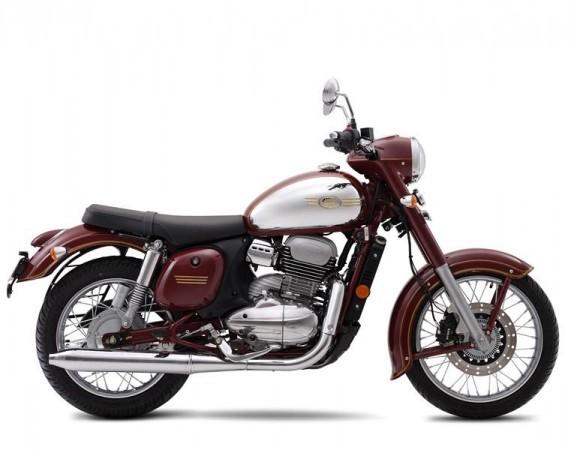A barrage of news articles earlier this month on Jawa BS6 deliveries and their engine's "cross-port technology" (among other claimed improvements to the BS6 Jawas) made headlines. But what raised a few eyebrows was the Classic Legends Pvt. Ltd.'s claim that their BS6 engine is the world's first single-cylinder engine with cross-port technology. You might have already read about it. In case you haven't, let me first quote the relevant paragraphs from their official press release below.
Jawa cross-port technology as mentioned in their press release [The Claim]
Both Jawa and Jawa forty-two continue to sport the 293cc, liquid-cooled, single-cylinder, DOHC engine. Both bikes now feature India's first cross port technology that increases the volumetric efficiency of the engine by enabling better flow of charge and exhaust gases, and improves power and torque output.

This engine is the world's first single-cylinder engine that uses the cross port configuration and develops similar power and torque to the BS4 configuration to offer the same superior riding experience to the customer. This tech also helps the motorcycles retain their characteristic twin exhaust identity and meet the stricter BS-VI emission standards while retaining similar power and torque numbers.
With the world's first Cross Port configuration on a single-cylinder engine, the Jawa's newly positioned lambda sensor monitors internal and external variables even more efficiently to give consistent performance and cleaner emissions regardless of any road condition. The throttle response has been made crisper to respond to even the slightest inputs with precision through improved fuelling."
Fact-check
First and foremost, perform a Google search with "cross port technology" as the search phrase, and see what you get? You'll get nothing except "Jawa BS6 delivery" news published all over by numerous automotive portals. It appears that every outlet just copied/ paraphrased the excerpts/paragraphs on the alleged "cross port tech" from Jawa's press release without even questioning what exactly is cross-port technology and how it works.
It seems that Classic Legends / Jawa R&D / Jawa marketing are misrepresenting "crossflow cylinder heads" as their own "cross port technology." Please note that all modern motorcycle and passenger car engines have had crossflow cylinder heads for decades now! The Jawa's engine isn't a novelty. Therefore, their claim of the Jawa engine being "the world's first single-cylinder engine that uses cross port configuration" is misleading.
Claim reviewed :
Jawa bikes have the world's first single-cylinder engine that uses cross port configurationClaimed By :
Manufacturer, news agencies.Fact Check :
MisleadingWhat is a crossflow cylinder head?
A crossflow cylinder head is one that has its intake and exhaust ports on opposite sides. For example, RE 350, Benelli Imperiale 400, Jawa, and all other motorcycles on sale right now that have a conventional internal combustion engine.
The main advantage of a crossflow cylinder head is better "volumetric efficiency" as compared to a reverse-flow cylinder head that has its intake and exhaust ports on the same side. Please scroll above (or do a Control F if you are reading this on your laptop/desktop) and check where else did "volumetric efficiency" appear in this article.
Examples of legitimate India-firsts by other motorcycle manufacturers
When Suzuki talked about their Gixxer 250s' oil-cooling technology—SOCS (Suzuki Oil Cooling System)—as being the first of its kind in India (as opposed to the comparatively rudimentary air- and oil-cooling), they went to great lengths in explaining what it is and how it works.

They didn't really have to—the world's first oil-cooled motorcycle engine was developed by them—but they chose not to rest on their laurels. Plus, you could anyway see the lack of fins and a radiator.

When Yamaha talked about their VVA (Variable Valve Actuation) technology in the YZF-R15 V3.0, they had the entire engine's innards in front of us to inspect.

Classic Legends, on the other hand, have not shared any credible literature, or even a picture, to substantiate their claim.
I had first written to them on 5 August asking them to explain what their cross-port technology is, and whether they are referring to crossflow heads. I had also asked them to send cut-section images/diagrams of the Jawa engine, but they couldn't send anything. Finally, on 13 August, this is what they sent to me:
Please find below the response and attached the press release for your reference.
"The cross port technology has been introduced specifically in the BS6 variants, and the Perak engine of course since that has been BS6 compliant right from the start. The cross-port technology increases the volumetric efficiency of the engine by enabling better flow of charge and exhaust gases, thus improving power and torque output. This tech also helps the motorcycles retain their characteristic twin exhaust identity and meet the stricter BS-VI emission standards. The benefits are further explained in the enclosed release."
The press release attached by them is the SAME press release that they had sent out originally! It does not contain anything new. All they have done in their "response" above is that they have added the Jawa Perak as well (that it too has cross-port technology).
The lack of a patent, and the company's inability to provide even a single proof in support of its claim corroborates our conclusion that their claim is absolutely false.
Of course, this story will be updated if the company is still able to substantiate their claim.















